Physical Address
304 North Cardinal St.
Dorchester Center, MA 02124
Physical Address
304 North Cardinal St.
Dorchester Center, MA 02124
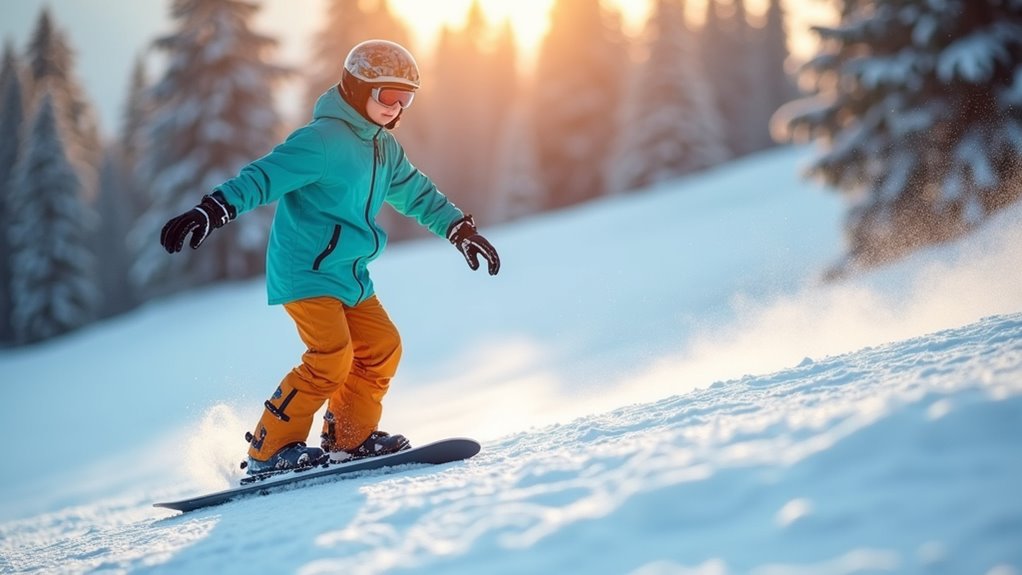
Our essential snowboarding safety guide reveals 12 crucial tips that could save you from becoming another beginner injury statistic.
Did you know that nearly 60% of snowboarding injuries happen to beginners within their first three trips down the mountain? You don’t have to become part of that statistic. While snowboarding’s learning curve can feel steep, most accidents aren’t random—they’re preventable with the right preparation and technique. Whether you’re strapping in for the first time or still finding your balance, there are specific strategies that’ll keep you upright and confident as you tackle those slopes.
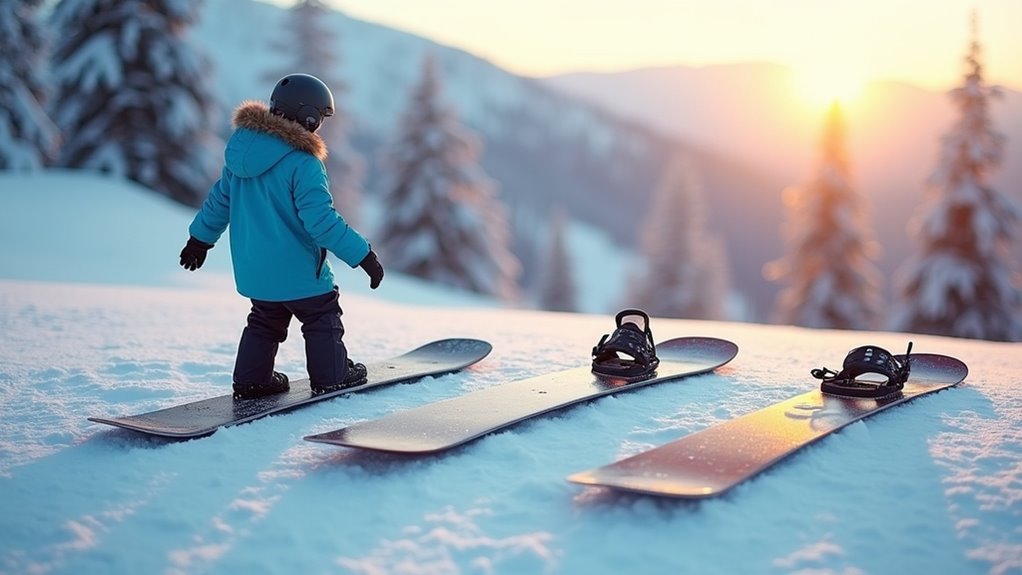
Before you even set foot on the mountain, you’ll need to select a snowboard that matches your abilities and learning goals.
As a beginner, you’ll want a shorter, softer board that’s forgiving when you make mistakes. Choose a board that reaches somewhere between your chin and nose when standing upright—this length offers better control and maneuverability.
Look for all-mountain boards with a softer flex rating, as they’re more forgiving than stiff competition boards. Avoid specialized boards like powder or freestyle models until you’ve mastered the basics.
Wider boards work better if you have larger feet, preventing toe and heel drag.
Don’t let salespeople pressure you into advanced equipment. Starting with beginner-friendly gear builds confidence and accelerates your learning process markedly.
Just as you prepare your gear for snowboarding, being prepared is equally crucial for any outdoor adventure, whether you’re hitting the slopes or camping in extreme conditions.
While selecting the right board matters, your boots and bindings will make or break your snowboarding experience. Properly fitting boots are essential—they should feel snug without causing pain or numbness.
Your boots and bindings determine whether you’ll have an amazing day on the mountain or a miserable one.
Your heel shouldn’t lift when you lean forward, and your toes should barely touch the boot’s front. Loose boots lead to blisters and poor control, while overly tight ones restrict circulation.
For bindings, make sure they match your boot size and riding style. Softer bindings offer more forgiveness for beginners, providing easier turns and reduced fatigue.
The binding’s baseplate should align with your boot’s sole, and straps must secure your foot without creating pressure points.
Don’t rush this decision—spend time at the shop trying different combinations. Quality boots and bindings improve your comfort, control, and overall learning experience considerably.
Just as divers understand that proper equipment prevents dangerous situations, snowboarders should recognize that quality gear is their first line of defense against injury on the slopes.
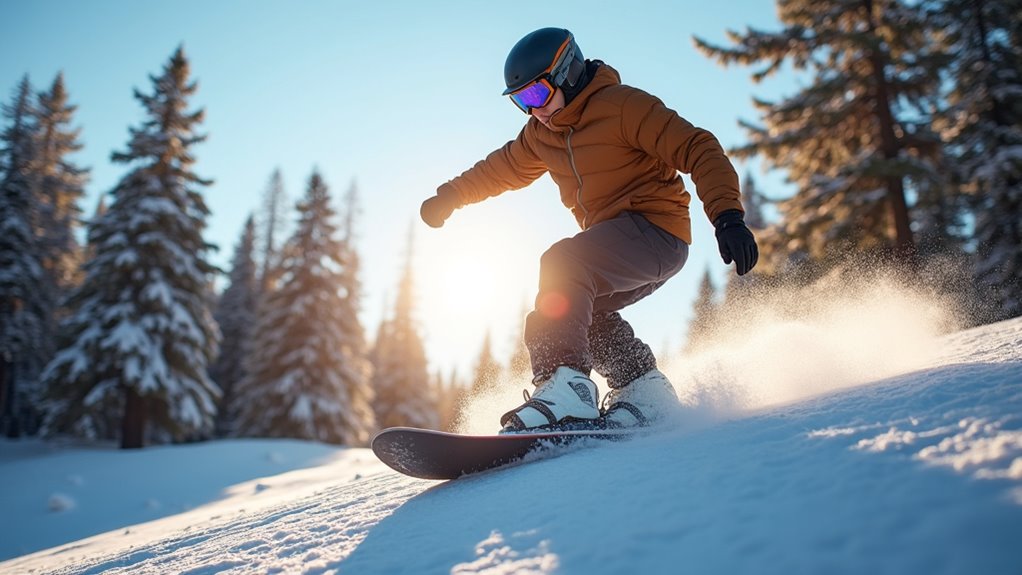
Once you’ve got your gear sorted, your stance becomes the foundation of everything you’ll do on the mountain. Start by determining if you’re regular (left foot forward) or goofy (right foot forward). Most people naturally step forward with their dominant foot when sliding on ice – that’s your back foot.
Position your feet shoulder-width apart with knees slightly bent. Keep your weight centered over the board, not leaning too far forward or back. Your shoulders should align with your board’s direction. Practice this stance on flat ground first.
Angle your bindings correctly – front foot around 15-18 degrees toward the nose, back foot slightly negative or neutral. This setup gives you better control and reduces strain on your knees during turns.
If you’re planning multi-day snowboarding trips to different mountains, consider how camping vans can provide convenient mobile accommodations that let you chase fresh powder wherever the conditions are best.
Although nobody plans to fall while snowboarding, you’ll inevitably take some tumbles as you’re learning – and that’s perfectly normal. When you feel yourself losing balance, don’t fight it. Instead, relax your body and aim to fall backward onto your bottom or forward onto your knees. Avoid catching yourself with outstretched hands, as this can cause wrist injuries.
Getting back up requires technique. If you’re on your back, roll over onto your stomach first. Place both hands flat on the snow near your board’s edges, then push yourself up while keeping your knees bent. Use your board’s edge for stability as you rise.
Practice falling and getting up on gentle slopes until these movements become second nature. Just like with any new activity, avoiding common mistakes early on will help you progress faster and enjoy your snowboarding experience more.
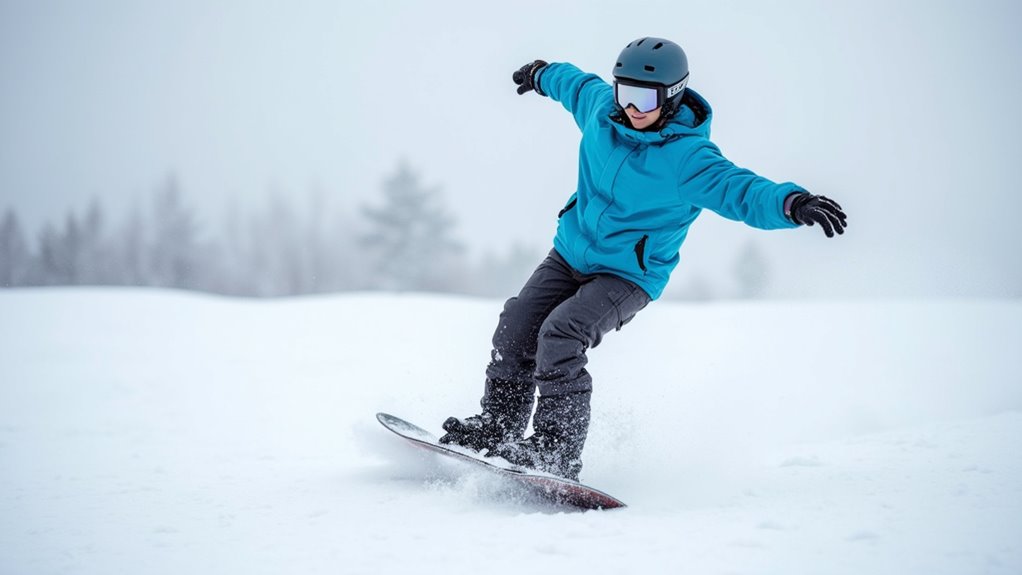
Before you tackle any slopes, you’ll want to master balance and weight distribution on flat terrain. This foundational step prevents countless tumbles and builds your confidence before heading downhill.
Start by strapping in and simply standing on your board. Feel how your weight shifts affect your stability. Practice these essential movements:
Spend at least 20 minutes mastering these basics. You’ll notice improved control immediately, making your first runs down gentle slopes much more enjoyable and safer. Like scuba diving, snowboarding requires you to identify and avoid common mistakes that beginners frequently make to ensure a safe and enjoyable experience.
When you’re ready to progress from flat ground to actual turning, heel-side turns should be your starting point since they’re naturally easier and feel more secure than toe-side turns.
You’ll lean back slightly on your heels, which feels more stable because you can see where you’re going and won’t face the scary prospect of falling forward downhill.
Start by linking gentle heel-side turns down a gentle slope. Keep your knees bent and apply gradual pressure to your heel edge.
You’ll naturally slow down as you turn across the fall line. Practice this motion repeatedly until it becomes second nature.
Once you’ve mastered heel-side confidence, you can tackle the trickier toe-side turns, knowing you’ve built solid foundational skills.
Just like how proper water filtration is essential for safety during extended outdoor adventures, mastering heel-side turns first creates the foundation you need before attempting more challenging maneuvers on the mountain.
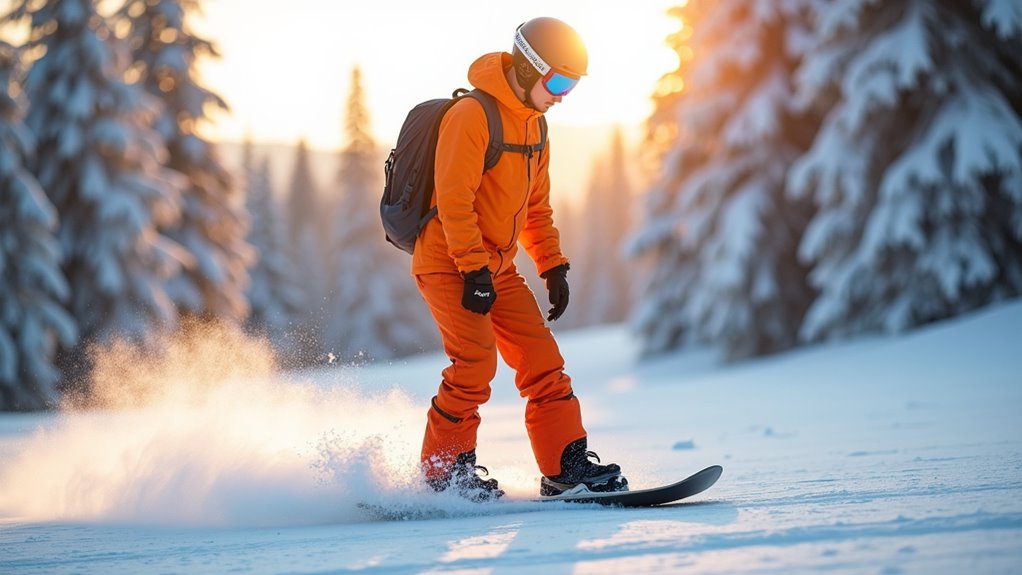
While learning proper turning technique is essential, your overall stance and balance form the foundation of every successful snowboarding movement. Keeping your knees bent and staying centered over your board will dramatically improve your control and confidence on the slopes.
Think of your knees as natural shock absorbers. When they’re bent, you can react quickly to changes in terrain and maintain better balance. Here’s what you need to focus on:
This centered position gives you the stability you need to progress confidently. Don’t forget to layer up with a stylish jacket to stay warm and comfortable during those long practice sessions on the mountain.
Now that you’ve mastered the fundamentals of proper stance, you’re ready to tackle speed control—one of the most important skills for safe and enjoyable snowboarding. Gentle S-turns are your best friend for managing speed while building confidence on the mountain.
Start by shifting your weight from heel to toe edge in smooth, flowing motions. Don’t force sharp turns—instead, let the board naturally carve gentle curves down the slope. Think of drawing lazy S-shapes in the snow rather than aggressive zigzags.
Keep your movements fluid and controlled. As you progression between edges, maintain that centered stance you’ve practiced.
If you’re picking up too much speed, make your turns wider and more frequent. Remember, it’s better to make too many gentle turns than to panic and catch an edge.
Once you’re comfortable with basic S-turns on groomed runs, you can eventually apply these same mogul skiing techniques to navigate more challenging terrain with bumps and irregularities.
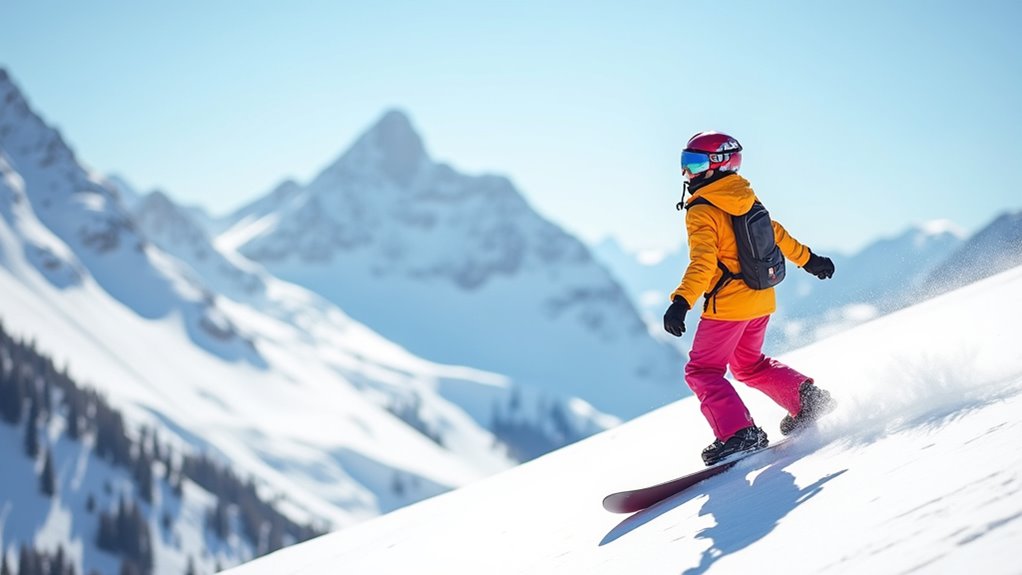
As you practice those gentle S-turns, you’ll notice a natural tendency to stare down at your snowboard—but this habit will sabotage your progress faster than almost anything else.
Your eyes guide your body’s direction, so looking down creates a dangerous cycle: you’ll lean forward, lose balance, and pick up unwanted speed. Instead, train yourself to look ahead toward where you want to go.
Here’s what proper vision control accomplishes:
Keep your head up and trust your peripheral vision to monitor your board’s position. Just like senior campers who learn to scan their surroundings for the best outdoor experiences, snowboarders benefit from maintaining awareness of the broader environment rather than fixating on their equipment.
When you’re learning to snowboard, timing your practice sessions can make the difference between a frustrating day and genuine progress. Peak hours typically run from 10 AM to 3 PM on weekends and holidays, when slopes become congested with skiers and snowboarders of all skill levels.
As a beginner, you’ll benefit enormously from practicing during quieter periods. Early morning sessions offer freshly groomed runs with fewer obstacles to navigate around.
Late afternoon skiing provides similar advantages, though visibility may decrease as daylight fades.
Crowded slopes create additional pressure and limit your space to make mistakes safely. You’ll have more room to practice turns, stops, and falls without worrying about colliding with others.
This extra space builds confidence faster and reduces your risk of injury notably. For those seeking more advanced challenges once they’ve mastered basic techniques, consider exploring glacier climbing trails that offer unique winter experiences beyond traditional resort slopes.
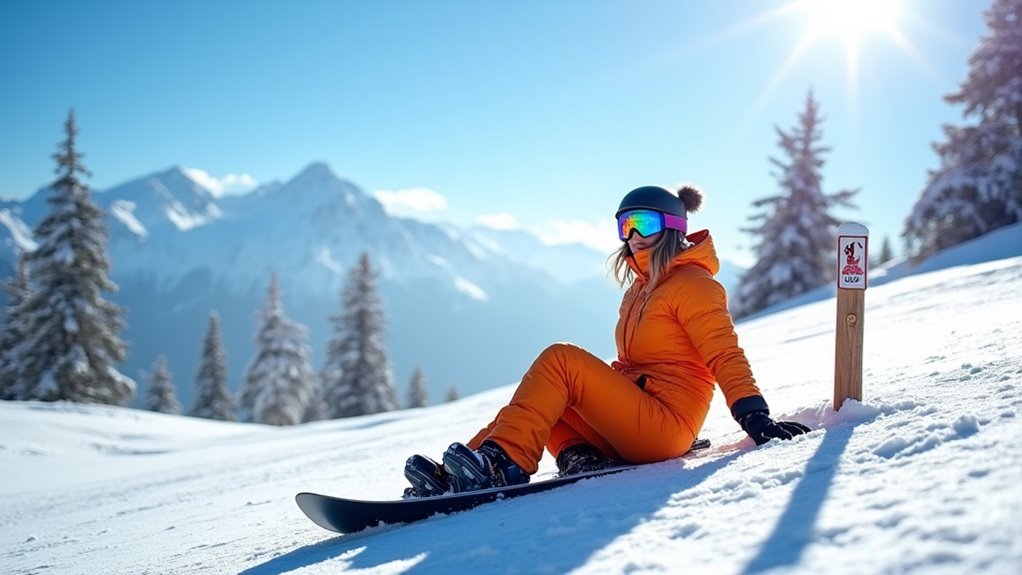
Because snowboarding demands intense physical effort from muscles you don’t typically use, you’ll tire much faster than expected during your first few sessions. Fatigue leads to poor judgment, slower reflexes, and increased injury risk. Don’t push through exhaustion—it’s counterproductive.
Smart break strategies include:
You’ll actually learn faster with regular rest periods. Fresh legs respond better to instruction and maintain proper form longer. Remember, snowboarding isn’t about marathon endurance—it’s about building skills progressively while staying safe and having fun. Many mountain backpacking principles apply to snowboarding, including the importance of pacing yourself and recognizing when your body needs rest.
While you might feel tempted to learn snowboarding on your own or from well-meaning friends, investing in professional lessons will accelerate your progress dramatically.
Certified instructors possess the expertise to teach proper body positioning, balance techniques, and turning mechanics from day one. They’ll help you avoid developing bad habits that could lead to injuries or plateau your improvement.
Professional lessons provide structured learning tailored to your skill level. Instructors can immediately spot and correct mistakes you wouldn’t notice yourself. They’ll teach you essential safety skills like how to fall properly and navigate different terrain confidently.
Most ski resorts offer beginner packages that include equipment rentals and group lessons at reasonable rates. Consider booking a few sessions – you’ll master fundamentals faster and enjoy the mountain with greater confidence and control.
Think of snowboarding like learning to dance with the mountain – you’ll stumble at first, but each fall teaches you the rhythm. You’re not conquering the slope; you’re having a conversation with it. Your board becomes an extension of yourself, responding to whispers rather than shouts. Remember, even the most graceful dancers started with two left feet. Trust the process, respect the mountain’s moods, and you’ll find your flow down those pristine white stages.